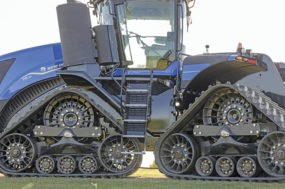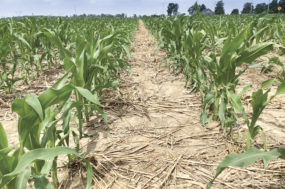I am sure we have all heard about how artificial intelligence (AI) is taking over the arts. Need an article written or a picture? Just ask ChatGPT. Well, the film industry has been open about their fear of being replaced by AI. We all have been awaiting the next season of Yellowstone due to the screen writers guild strike. Well, a large part of that strike was coming to an agreement on how AI can be utilized within the film industry as a tool, but not to replace writers.
Recently, I have heard similar issues coming from animal nutritionists. I have heard concern that AI could replace professionals in balancing rations or making supplementation recommendations. But, like the writers, I believe AI can be a powerful tool, but it cannot replace thought leadership and innovation within our industry. First, let us look at what has recently been implemented for on-farm AI. Then, how feed mills can start to benefit farm AI technologies and, finally, where do professional consultants fit into this new landscape?
AI on the farm
There are lots of exciting new tools and capabilities for implementing AI on-farm. Animals can be fitted for sensors. Sensors can be in the form of eartags, nose bands, tail bands, ankle monitors and even sensors in their reticulorumen. Some of the data these sensors are collecting include body temperature, activity level, drinking time, rumination time, time spent grazing or at the feedbunk – and of course location. Additionally, cameras in housed livestock facilities can be used to evaluate body temperature, body condition and other behaviors as well. Cameras can also be mounted to all-terrain vehicles to monitor animals out on pasture, evaluate available forages and provide more information to improve land management.
So we have sensors and cameras collecting an excessive amount of data; here is where AI comes in. AI can compile large datasets and start to recognize patterns. Then, once a pattern emerges, an event outside the norm can inform and alert farm managers. This can reduce morbidity and mortality rates and thereby improve herd health.
For example, if a mixing error were made on a load of feed resulting in subclinical acidosis, the sensors could note the animals that went off feed or had an increased body temperature. This can be detected before pen riders would notice, and the farm manager could investigate and mitigate the issue before a clinical acidosis case emerged from days consuming improperly mixed feed. In this case, AI does not replace any labor but enhances the efficiency of identification of common issues that cost livestock producers money.
Which brings us to the major drawback to the implementation of this type of AI: the cost. These sensors are relatively high cost and, while they can result in cost savings over time, the initial cost is an obstacle to adoption for many producers.
AI at the feed mill
Feed mills already have huge databases of historical data including inventory of specific ingredients, potential nutrient contents of those ingredients and customer orders. AI can improve efficiency of the feed mill through projections based on this existing data. Feed forecasting is a buzz phrase I have come across to describe how feed mill data can be used to make the right batch of feed at the right time based on customer historical data and animal information. This means potentially the feed mill can use information about the frequency of feed purchases from specific customers to improve their efficiency and be able to anticipate who needs feed and what their animals’ requirements are.
At the feed mill, managers still play a critical role. Along with checking the AI recommendation, they will play a critical role in collaborating with customers to improve on the AI prediction based on customer changing needs.
AI and the livestock consultant
Can AI be trained and utilized to balance a ration? Absolutely. Can AI replace the professional livestock consultant? I think not. Like the feed mill manager, livestock consultants can use AI as a tool, but they will need to be double checking that the recommendation produced is accurate and free of issues that may cause harm to livestock.
Rather than seeing AI as a threat, we should see it as a tool to make progress within the industry. Even with the ration-balancing tools currently available, most nutritionists I work with are not balancing their beef rations based on the 2016 Nutrient Requirements of Beef Cattle recommendation to use the metabolizable protein (MP) system. Instead, they are still using crude protein (CP) and energy and linear algebraic equations. I am even guilty of this myself. AI brings a tool that, given access, can utilize the latest research and recommendations to improve our efficient feed utilization. This means we can implement practical research innovations sooner.
Further, I do believe we need to adjust what we think of as a livestock consultant’s job and training. Most good livestock consultants already read and try to stay abreast of the most up-to-date research and recommendations, even if they cannot act on them. With AI coming onto the scene, it will be imperative that consultants are aware of both recent developments and have a solid background and understanding of what would be reasonable for a livestock diet. This will ensure corrective action when AI does inevitably go astray. We need to be the technology expert and support livestock producers, a role not far from the one we already play.
Additionally, we need to adapt and upskill to become knowledgeable data scientists, not just algebra experts. To remain experts in our field, we will need to understand modeling, big data, predictive analytics and how AI implements these concepts. Secondary education for professional animal nutritionists should evolve to include computer and data science coursework; the two semesters of statistics to perform research is no longer enough. Continued training through our professional organizations such as the American Registry of Professional Animal Scientists should also start to focus on data and computer technology skills and how they can be used in livestock production.
In conclusion, artificial intelligence seems to have been a buzzword taking over many aspects of our society, from marketing to film and now even animal agriculture. But it is not a bad thing, and it is not going away anytime soon. Computers can do a lot, but they cannot replace the ingenuity, critical thinking and unique perspectives of people. And that includes livestock professionals.












